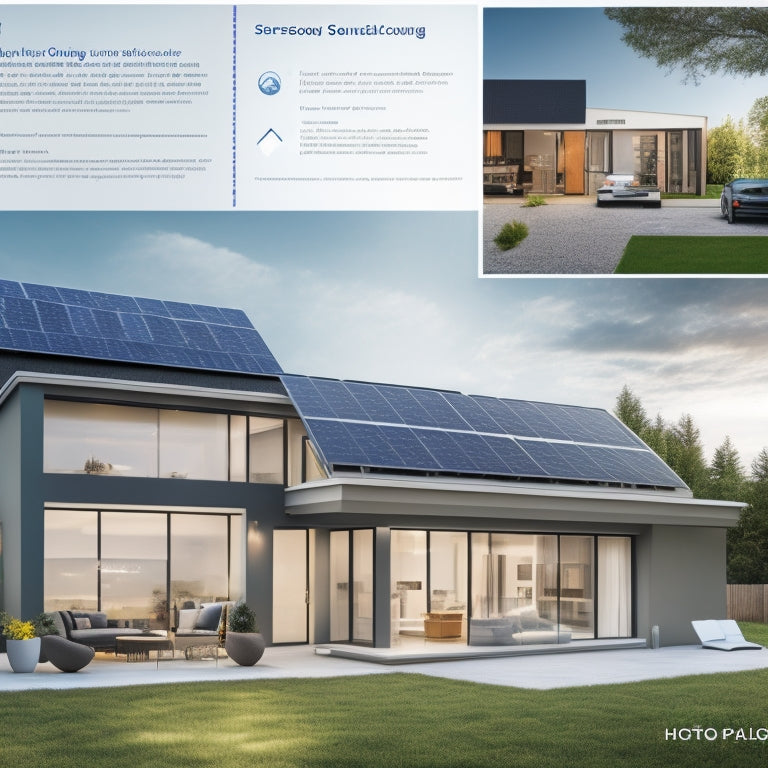
Home Battery Storage Prices
Share
You can expect to pay between $7,000 and $15,000 or more for a home battery storage system, depending on factors such as your energy usage patterns, desired backup duration, and the type of battery technology used. System sizing, power needs, and daily energy usage patterns all play a vital role in determining the overall cost. Additionally, considerations like depth of discharge, cycle life, and load management strategies can impact the system's performance and lifespan. As you investigate the world of home battery storage, understanding these complex factors is key to optimizing your system for cost savings, efficiency, and energy independence - and there's more to uncover.
The Essentials
- Home battery storage prices vary depending on system size, wattage requirements, and desired backup duration, with costs ranging from $5,000 to $20,000 or more.
- The cost of home battery storage systems is influenced by the type and quality of batteries, with higher-efficiency batteries often being more expensive.
- Peak hour shaving and load management strategies can help offset the cost of home battery storage systems through reduced electricity bills and potential utility incentives.
- Battery lifespan and maintenance costs should be factored into the overall price, as deeper depths of discharge can shorten battery life and increase maintenance needs.
- The environmental impact and round-trip efficiency of home battery storage systems can also influence pricing, with more efficient and eco-friendly options potentially commanding a premium.
Reduce Peak Hour Bills
You can greatly reduce your peak hour bills by implementing peak hour shaving and load management strategies with your home battery storage system.
By integrating a battery storage system into your solar setup, you'll have more control over your energy bills solar power storage and can store energy to use during peak hours, rather than relying on the grid and incurring high costs.
By shaving peak hours, you'll decrease your energy consumption during periods of high demand, thereby lowering your electricity costs.
Peak Hour Shaving
Many households struggle with high electricity bills during peak hours, typically occurring between 4 pm and 9 pm, when energy consumption surges. This is where peak hour shaving comes in – a strategy that employs home battery storage to reduce your energy bills.
By installing a battery storage system, you can store excess energy generated by your solar panels or the grid during off-peak hours and use it during peak hours when energy prices are high. This approach helps shave off the peak demand, reducing your reliance on the grid and saving you money.
In fact, with a reliable battery backup system, you can guarantee continuous power supply for vital systems like medical equipment, security systems, and HVAC units Backup Power Solutions, which is especially important for households with specific needs.
With advanced battery technology, you can maximize your energy storage to meet your specific needs. By monitoring your energy usage patterns, you can program your battery to discharge during peak hours, reducing your energy consumption from the grid.
This not only lowers your electricity bills but also provides you with a sense of freedom from the constraints of traditional energy pricing. By leveraging the power of energy storage, you can take control of your energy costs and enjoy significant savings over time.
Load Management Strategies
Optimizing energy consumption through load management strategies is essential to reducing peak hour bills. By leveraging smart technology, you can analyze your energy usage patterns and identify opportunities to shift non-essential loads to off-peak hours. This not only reduces your energy costs but also helps minimize your environmental impact.
Effective load management involves energy forecasting to predict your energy needs and adjust your consumption accordingly. With the ability to provide a reliable source of backup power during outages, a Home Backup Power system can also help you optimize your energy consumption. Additionally, by reducing your reliance on noisy, polluting generators, you can create a more sustainable and environmentally friendly home.
With a home battery storage system, you can store excess energy generated during the day for use during peak hours, reducing your reliance on the grid. Proper battery management is vital to guarantee the longevity of your system. Regular maintenance tips, such as monitoring your system's performance and updating your software, can help you maximize your cost savings.
Additionally, many utilities offer buying incentives for homeowners who invest in load management strategies. When exploring installation options, consider factors such as your energy usage, budget, and local incentives to determine the best approach for your home.
Increased Grid Independence
With home battery storage, you're no longer at the mercy of the grid's schedule, allowing you to have energy on your terms.
You can store excess energy generated during the day for use during peak hours or power outages, ensuring you have power when you need it.
By leveraging renewable energy storage solutions, such as solar battery systems, you can optimize your energy usage and reduce your reliance on the grid.
Energy On Your Terms
You're taking a significant step towards energy self-sufficiency by investing in a home battery storage system, which enables you to employ energy on your terms. With a home battery storage system, you can optimize your energy usage and reduce your reliance on the grid. This means you can store excess energy generated by your solar panels during the day and use it at night or during power outages.
| System Component | Description | Benefit |
|---|---|---|
| Solar Integration | Allows seamless integration with your solar panel system | Maximizes energy harvesting and reduces grid dependence |
| Battery Compatibility | Enables compatibility with a wide range of battery types and sizes | Provides flexibility and customization options for your energy storage needs |
| Energy Management System | Monitors and controls energy usage, storage, and generation | Optimizes energy efficiency and reduces energy waste |
Power When You Need
Grid independence is within reach with a home battery storage system, enabling you to access power when you need it most. With advanced battery technology, you can store excess energy generated by your solar panels or wind turbines during the day and use it to power your home at night or during outages. This means you're no longer reliant on the grid to keep your lights on and your appliances running.
Imagine having the freedom to use energy on your own terms, without worrying about peak hour rates or unexpected blackouts. With a home battery storage system, you can do just that. By utilizing the power of energy storage, you can reduce your reliance on the grid and enjoy uninterrupted power supply.
This is especially vital for households with critical medical equipment, home offices, or those living in areas prone to natural disasters.
With a home battery storage system, you're in control of your energy usage, and that's a powerful feeling. You can monitor your energy consumption, optimize your usage, and even sell excess energy back to the grid.
It's time to take back control of your energy and experience the freedom that comes with it.
Depth of Discharge Matters
When you're evaluating home battery storage options, you need to take into account how deeply you'll be discharging your batteries on a daily basis.
This depth of discharge (DOD) has a significant impact on the battery's cycle life, as frequent deep discharges can reduce the overall lifespan of the system.
For instance, using solar energy storage solutions can help mitigate this issue by providing a reliable backup power source.
Additionally, pairing your battery storage with a grid tie system can also help regulate your energy usage.
Your daily usage patterns, including the amount of energy you consume and when you charge your batteries, will also influence the ideal DOD for your specific application.
Cycle Life Impact
As battery storage systems become an integral part of your renewable energy setup, it's vital to understand the intricacies of cycle life impact, a key factor affecting the overall performance and lifespan of your home battery. Cycle life refers to the number of charge and discharge cycles a battery can handle before its capacity degrades.
| Depth of Discharge (DOD) | Cycle Life |
|---|---|
| 50% | 3,000 - 5,000 cycles |
| 70% | 1,500 - 3,000 cycles |
| 80% | 1,000 - 2,000 cycles |
| 90% | 500 - 1,500 cycles |
| 100% | 300 - 1,000 cycles |
As you can see, the deeper you discharge your battery, the fewer cycles it'll last. This has significant implications for your battery lifespan, maintenance costs, and environmental impact. Technology advancements have improved cycle life, but it's still essential to evaluate warranty terms, installation factors, and market trends when selecting a battery. User experiences also highlight the importance of balancing depth of discharge with cycle life to minimize costs and maximize freedom from the grid.
Daily Usage Patterns
Your daily energy usage patterns have a significant impact on the overall performance and lifespan of your home battery storage system. The depth of discharge (DOD) matters, as it affects the battery lifespan and usage efficiency. A deeper DOD means more energy is extracted from the battery, reducing its lifespan. Conversely, a shallower DOD prolongs the battery's life but may not fully capitalize on its energy storage capacity.
When conducting a cost analysis, consider your daily energy usage patterns to optimize your home battery storage system's performance. For instance, if you have a high energy demand during peak hours, you may want to install a system that can provide a higher DOD. This will guarantee you maximize your energy storage and reduce your reliance on the grid, leading to a lower environmental impact.
Recent technology advancements have improved user experience, allowing for more efficient installation considerations and flexible market trends. However, it's essential to prioritize grid reliability when designing your system.
Wattage for Your Home
When selecting a home battery storage system, you'll need to determine the required wattage to meet your power needs.
For instance, considering a system like the Tesla Powerwall, which offers 13.5 kWh of energy storage, can help you better understand your power requirements.
A thorough power needs assessment is essential to guarantee your system can handle peak demand periods, such as when multiple appliances are running simultaneously during outages and emergencies.
The system size you choose will directly impact your overall energy independence and cost savings.
System Size Matters
Three key factors determine the ideal system size for your home battery storage: your energy usage patterns, the available roof space for solar panels, and the desired backup duration during outages.
Considering these factors will help you choose the right battery type and size for your needs. For instance, if you have high energy usage and limited roof space, you may opt for a larger, more efficient battery like the Tesla Powerwall. On the other hand, if you have moderate energy usage and ample roof space, a smaller battery like the LG Chem RESU might be more suitable.
Here's a comparison of popular battery types and their characteristics:
| Battery Type | Capacity (kWh) | Installation Cost ($/kWh) | Warranty (Years) |
|---|---|---|---|
| Tesla Powerwall | 13.5 | 400-500 | 10 |
| LG Chem RESU | 3.3-12.8 | 300-400 | 10 |
| Sonnen eco | 2-16 | 500-600 | 10 |
| SimpliPhi Power | 2.2-3.9 | 400-500 | 10 |
| Generac PWRcell | 8.6-17.1 | 500-600 | 10 |
When selecting a battery, consider not only installation costs but also maintenance considerations, warranty options, and brand comparisons. Additionally, think about the environmental impact, technology advancements, government incentives, financing solutions, and user experiences that come with each option. By evaluating these factors, you'll be able to choose the ideal system size for your home battery storage needs.
Power Needs Assessment
Most homes require a minimum of 5-10 kilowatts of power to operate essential appliances during an outage, and your power needs evaluation should determine the exact wattage required for your home.
This evaluation is vital in determining the right battery capacity for your home battery storage system. You'll need to take into account the type and number of appliances you want to power during an outage, as well as their individual wattage requirements. For instance, a refrigerator typically requires around 2 kilowatts, while a medical device might require only 100 watts.
Energy forecasting is also an important component of your power needs evaluation. By analyzing your energy usage patterns, you can identify peak demand periods and determine the required battery capacity to meet those demands.
This information will help you size your battery storage system correctly, ensuring you have the power you need when you need it. By accurately evaluating your power needs, you'll be able to enjoy the freedom and independence that comes with having a reliable source of backup power.
Higher Round-Trip Efficiency
You're likely aware that traditional battery systems suffer from energy losses during charging and discharging.
To mitigate this, manufacturers have developed higher round-trip efficiency batteries that reduce energy loss.
Energy Loss Reduction Method
In a battery storage system, energy losses occur when electrons flow in and out of the battery, reducing the overall efficiency of the system.
To minimize these losses, you'll want to evaluate an energy loss reduction method. This method involves optimizing the system's design and components to reduce energy waste, resulting in higher round-trip efficiency.
When selecting a battery storage system, look for products with high battery efficiency ratings. These ratings indicate the percentage of energy stored in the battery that's available for use.
Higher efficiency ratings translate to less energy waste and lower installation costs in the long run. For example, a system with a 95% efficiency rating will waste less energy than one with an 80% rating, resulting in significant savings over time.
Frequently Asked Questions
Can I Install Home Battery Storage Myself?
You can attempt a DIY installation, but be aware that it's vital to prioritize safety considerations, ensuring you have the necessary knowledge and follow manufacturer guidelines to avoid electrical shock, fire hazards, and system malfunction.
Are Home Battery Storage Systems Environmentally Friendly?
You're basically a superhero, saving the planet from fossil fuels' evil grip, as home battery storage systems slash environmental impact, releasing sustainability benefits that'll make the Earth breathe a collective sigh of relief!
How Long Do Home Battery Storage Systems Last?
You'll find that home battery storage systems can last around 10-15 years, depending on the battery type and maintenance requirements, such as regular software updates, temperature control, and occasional cell replacement, which affect battery lifespan.
Can I Use Any Type of Solar Panel With Home Battery Storage?
Oh, you think you can just slap any old solar panel onto your home battery storage system? Think again! You need compatible panels that won't drain your battery's efficiency; look for ones with high voltage and low impedance to maximize your energy freedom.
Are Home Battery Storage Systems Compatible With All Electrical Systems?
You'll find that compatibility largely depends on compatibility factors, such as voltage, frequency, and electrical standards, ensuring seamless integration with your electrical system, so it is crucial to choose a system that adheres to your local electrical standards.
Final Thoughts
As you consider investing in home battery storage, it's likely that reducing peak hour bills and increasing grid independence are top of mind. By selecting the right depth of discharge and wattage for your home, you'll be well on your way to achieving these goals. Coincidentally, higher round-trip efficiency will also become a sweet bonus, further maximizing your savings.
Related Posts
-

Net Metering in Renewable Energy's Future
Net metering's future is vital for driving renewable energy growth and financial savings. You can reduce your electri...
-

Smart Home Thermostats to Revolutionize Your Space
Smart home thermostats revolutionize your space by providing precise temperature control and optimizing energy saving...
-

Essential Hiking Lights for Safety and Fun
When you're hitting the trails, essential hiking lights are vital for safety and fun. A lightweight headlamp offers h...


